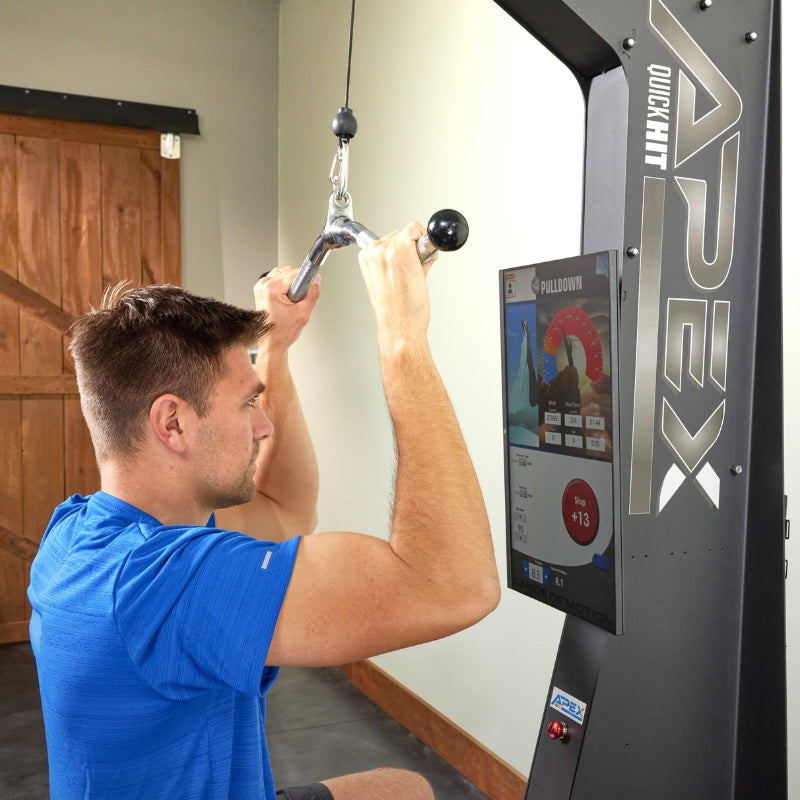Isometric Overload: Unlocking the Power of Static Strength Training for Improved Health and Performance

Isometric overload training is a unique and effective fitness approach that offers numerous benefits for individuals seeking to enhance their health and athletic performance. By focusing on static muscle contractions, isometric overload training provides a distinct set of advantages, setting it apart from traditional strength training methods. QuickHIT technology takes full advantage of these concepts with the Apex and the Pinnacle, but this type of exercise is possible even without QuickHIT gear around. In this article, we will delve into the benefits of isometric overload training and how you can incorporate it into your fitness routine even without access to QuickHIT technology
Understanding Isometric Overload:
Isometric overload training involves maintaining a static muscle contraction for an extended period. Unlike traditional strength training exercises that involve concentric and eccentric muscle contractions, isometric exercises focus on holding the muscle under tension without lengthening or shortening it. This form of exercise can lead to increased muscle strength, endurance, and overall functionality.
Benefits of Isometric Overload:
a. Increased Strength and Endurance: By focusing on static muscle contractions, isometric overload training helps develop muscle strength and endurance simultaneously. Holding a muscle contraction for an extended period creates a high level of muscular tension, stimulating adaptations that lead to improved strength and stamina.
b. Reduced Risk of Injury: Isometric overload exercises are often considered safer than dynamic strength training movements because they place less stress on joints and connective tissues. By eliminating the need for repetitive, high-impact movements, isometric overload training can help reduce the risk of injury and improve joint health.
c. Enhanced Core Stability: Many isometric exercises, such as planks and side bridges, target the core muscles responsible for maintaining spinal stability and posture. Developing a strong core through isometric overload training can help protect the spine, prevent back pain, and improve overall functional fitness.
d. Improved Muscle Activation: Isometric overload training can help individuals learn how to activate and engage specific muscle groups more effectively. By isolating and focusing on a particular muscle during a static contraction, individuals can enhance their mind-muscle connection and improve neuromuscular control.
e. Greater Flexibility: By holding a muscle contraction at the end of its range of motion, isometric overload exercises can also help improve flexibility. This form of static stretching can increase the muscle's capacity to stretch, leading to enhanced mobility and reduced risk of injury.
Incorporating Isometric Overload Training into Your Fitness Routine:
Isometric overload exercises can be easily integrated into any fitness program. Here are a few tips for incorporating this powerful training method into your routine:
a. Start with Basic Exercises: Begin with simple isometric exercises, such as planks, wall sits, and glute bridges, to familiarize yourself with the technique and develop a strong foundation.
b. Gradually Increase Duration and Intensity: As you become more comfortable with isometric overload exercises, gradually increase the duration and intensity of the contractions. Aim to hold each contraction for longer periods, or incorporate additional resistance to challenge your muscles further.
c. Combine Isometric and Dynamic Exercises: For a well-rounded workout, combine isometric overload training with dynamic strength training exercises. This approach will ensure you target all aspects of muscle function, leading to more balanced and effective workouts.
d. Focus on Proper Form: When performing isometric exercises, it is essential to maintain proper form and alignment. Be mindful of your posture and positioning throughout each exercise to maximize the benefits and minimize the risk of injury.
e. Incorporate Recovery: Ensure you allow adequate time for recovery between isometric overload workouts. As with any strength training method, your muscles need time to recover and adapt to the demands placed on them.
Conclusion: Isometric overload training offers a unique and powerful approach to strength training, providing numerous benefits for individuals seeking to improve their health and athletic performance. By incorporating this method into your fitness

